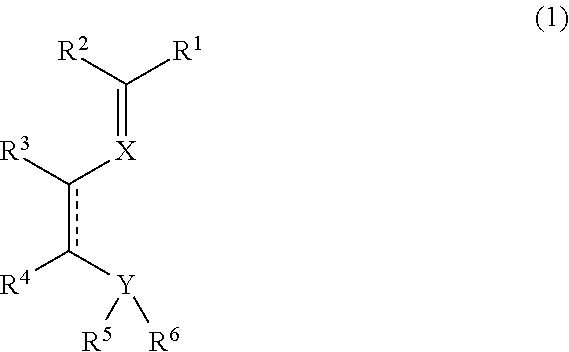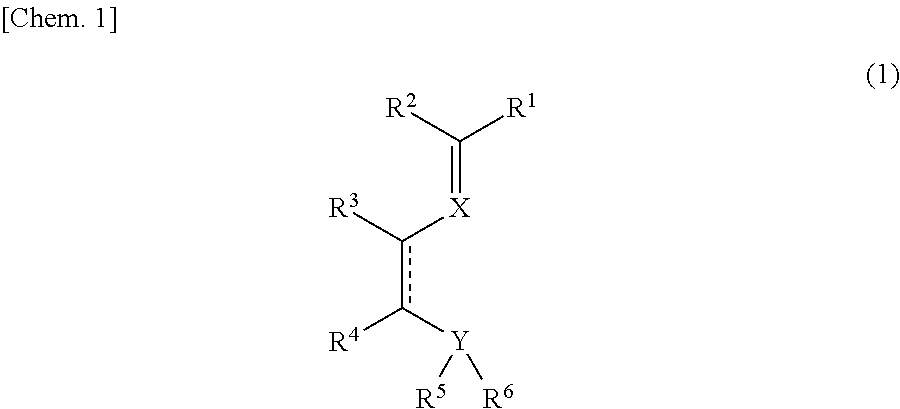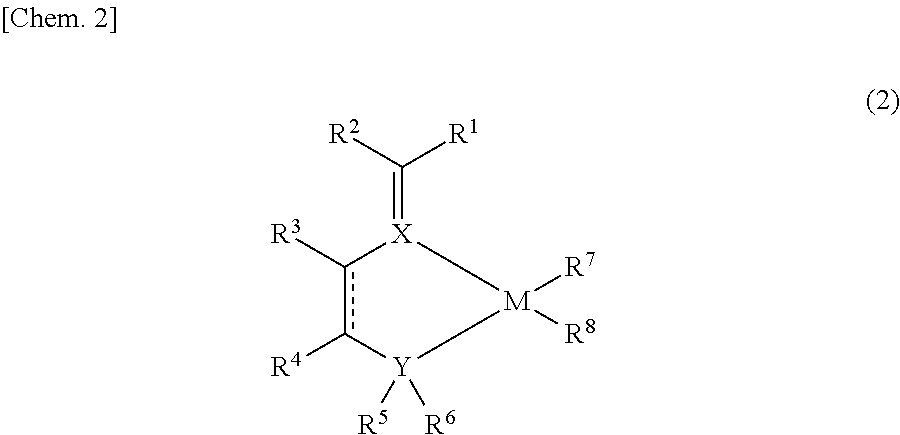Imine compound, novel catalyst for olefin polymerization, and process for producing olefin polymer
a technology of olefin polymerization and catalyst, which is applied in the direction of platinum organic compound, platinum group organic compound, platinum group organic compound, etc., can solve the problems of limited catalysts for producing such polyolefin resin, and achieve high molecular weight, efficient production, and high molecular weight
- Summary
- Abstract
- Description
- Claims
- Application Information
AI Technical Summary
Benefits of technology
Problems solved by technology
Method used
Image
Examples
examples
[0136]The present invention will be explained below in detail by reference to Examples to demonstrate the rationality and meaningfulness of the configuration of the invention and the superiority thereof over prior-art techniques.
1. Evaluation Method
(1) Weight-Average Molecular Weight Mw, Number-Average Molecular Weight Mn, and Molecular Weight Distribution Mw / Mn:
[0137]The molecular weights and the distribution were determined through the following GPC measurement.
[0138]First, a sample was introduced in an amount of about 20 (mg) into a vial for pretreatment device PL-SP260VS for high-temperature GPC, manufactured by Polymer Laboratories Ltd. o-Dichlorobenzene containing BHT as a stabilizer (BHT concentration=0.5 g / L) was added thereto to adjust the polymer concentration to 0.1 (% by weight). The resultant mixture was heated to 135° C. in the pretreatment device PL-SP260VS for high-temperature GPC to dissolve the polymer, and the solution was filtered with a glass filter to prepare a...
synthesis examples 1 to 3
[Synthesis Examples 1 to 3] Synthesis of Imines
[0142]Synthesis routes for synthesizing imine compound 1 and compound 2 according to the invention are shown below. In the following Synthesis Examples, the operations were performed in a purified-nitrogen atmosphere and the solvents used were ones which had been dehydrated and deoxidized, unless otherwise indicated.
synthesis example 1
[Synthesis Example 1]: (Synthesis of Ligand B-230)
[0143]Ligand B-230 was synthesized in accordance with the following scheme.
[0144]
(i) A solution of sodium nitrite (6.90 g, 100 mmol) in water (100 mL) was added dropwise at −5° C. to a solution of compound 1 (17.7 g, 100 mmol) in HBr (100 mL) and water (100 mL). Furthermore, a solution of CuBr (14.4 g, 100 mmol) in HBr (100 mL) was gradually added thereto at 0° C. The reaction solution was stirred at 0° C. for 30 minutes and at 50° C. for 3 hours. After cooling to 20° C., it was treated with saturated Na2S2O3 (200 mL), extracted with EtOAc (500 mL×3), washed with saturated NH4Claq (200 mL), and concentrated to give crude product. The crude product was purified with a silica gel column (petroleum ether) to give compound 2.
(ii) To a solution of compound 2 (0.50 g, 2.10 mmol) in THF (10 mL) was added a hexane solution of n-butyllithium (2.5 M, 0.84 mL, 2.10 mmol) at −78° C. This mixture was stirred at −78° C. for 30 minutes and to it wa...
PUM
| Property | Measurement | Unit |
|---|---|---|
| reaction temperature | aaaaa | aaaaa |
| reaction temperature | aaaaa | aaaaa |
| temperature | aaaaa | aaaaa |
Abstract
Description
Claims
Application Information
 Login to View More
Login to View More - R&D
- Intellectual Property
- Life Sciences
- Materials
- Tech Scout
- Unparalleled Data Quality
- Higher Quality Content
- 60% Fewer Hallucinations
Browse by: Latest US Patents, China's latest patents, Technical Efficacy Thesaurus, Application Domain, Technology Topic, Popular Technical Reports.
© 2025 PatSnap. All rights reserved.Legal|Privacy policy|Modern Slavery Act Transparency Statement|Sitemap|About US| Contact US: help@patsnap.com



